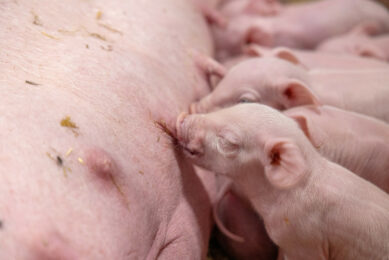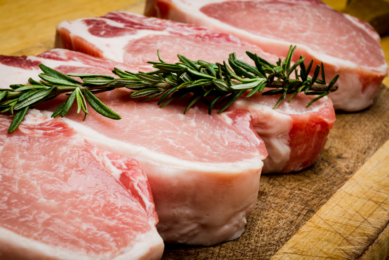Can gene editing solve the castration issue?

Gene editing, a relatively new technology, is being introduced commercially. Recently, a the company Recombinetics from Minnesota, United States, even announced a solution for boar taint in swine genetics by gene editing. What are the chances of success and public acceptance?
Gene editing or precision breeding technology is hot these days. The technique is promising. Every time a new technology comes up it could bring new opportunities for issues that have proven to be difficult to solve. Boar taint is such an issue. In fact, it is an off odour, caused by increased androsterone, skatole or indole levels in meat from mature intact boars.
Castration has been widely applied in the pork industry to avoid these problems in meat products. But in the last decades public opinion seems to be less willing to accept this type of surgical interference. This has been one of the reasons the European Union (EU) declared a ban on pig castration by January 2018. Unfortunately, however, that failed to provide any solutions. This is why the pig sector is desperately looking for alternative solutions. Gene editing could be a solution worth considering.
CRISPR
Gene editing or ‘Clustered Regularly Interspaced Short Palindromic Repeats’ (CRISPR) was introduced roughly a decade ago and received a lot of attention over the last couple of years as being the next revolution in genetics and biomedical research.
Until recently, DNA editing had been a relatively inexact process. CRISPR was presented as a way to change a single letter in the DNA through an enzyme that cuts DNA, copied from a natural bacterial defence system. CRISPR/Cas9-enzyme is the most well-known, but in the meantime, other varieties like Cpf1 and Mad9 have been introduced. This new technique is often referred to as ‘gene editing’ or ‘precision breeding’.
Will this new technology bring new opportunities for genetic programmes in the next decades? Although it is not genetic modification and creates genotypes that are naturally occurring, it might not be easy to get the products of this technique accepted by legislation or public opinion. The latter might not understand the nuances between GMO and gene-editing. But it is certainly not stopping researchers and the industry from experimenting with it.

The technology seems easy and readily available for most laboratories that are normally equipped. Agricultural universities and startups have shown the first examples of gene-edited cattle, pigs, sheep, goats, rats, and mice. The technique appears revolutionarily simple. Labs can easily order RNA varieties focused on a specific gene and test which of them works well. Experts can see results within a couple of weeks after ordering their CRISPR-kit. No wonder there is a lot of excitement to start tackling diseases or traits that are linked to a couple of specific genes or genetic markers that seem to have a large impact.
First attempts
Recombinetics, a US-based company, initiated one of the first attempts to bring this new gene-editing technique to the market for farm animals. Their first results were in dairy cattle where polledness in Angus breeds was introduced in top genetic embryos. This single locus autosomal trait dealing with two alleles, where polled allele (P) is dominant to horned allele (p), seems a logical candidate for gene editing. And the results of the first polled calves born out of gene-edited embryos prove that the technique works.
In pig breeding, searching for single locus traits that have a major impact seems a logical step. Researchers have focused on disease resistance traits, amongst others against African Swine Fever and PRRS, where a single locus can be linked to disease resistance.
Next targets: Genetic improvement
The next targets will be traits that are difficult to tackle with normal genetic improvement, but where a few genetic markers may have a major impact. Looking at welfare-related traits might be a logical choice. Boar taint is one of those traits that does not appear to be so easy to solve, so trying it with another type of technology might provide new opportunities.
To estimate what the potential of CRISPR technique has for boar taint, it is necessary to look at the natural occurring variation in boar taint. In fact, when a large part of this genetic variation can be linked to a limited amount of genetic markers, there is potential for tweaking specific alleles to lower boar taint.
Boar taint has been linked to androsterone and skatole levels. Heritability for both traits are estimated in the range from 0.5-0.6. A high heritability means that breeding for this trait should be rather successful. However, undesired genetic correlations like e.g. the ones that are sometimes found with sexual maturity might create unfavourable responses in reproduction traits. One of the main problems for active breeding programmes to tackle boar taint is that it is not easy or cheap to measure.

Delays in sexual maturity
Any impact on the reproduction of gene-editing, like delays in sexual maturity, will also have to be taken into account. In maternal lines, any negative impact on reproduction could be a show stopper, since selection experiments for lower androsterone have led to delayed puberty in gilts.
In terminal sire lines, research demonstrated high genetic correlations (>0.5) between age at sexual maturity and androsterone levels in meat. Duroc breeds tend to have the highest androsterone levels, much higher than Landrace or Large Whites. Piétrain breeds also tend to have higher levels of androsterone, but much lower levels of skatole than Duroc breeds. The search for breeding for lower androsterone or lower skatole levels without direct impact on sexual maturity in boars seems to be a logical one.
SNPs having an impact
Several studies on the genetics of boar taint reveal Single Nucleotide Polymorphisms (SNPs) that have a relatively large impact. The impact of targeting these specific SNPs with gene-editing differs per breed or line. Several recent studies focused on this in the last decade. A Danish Genome-Wide Association Study (GWAS) revealed SNP-association for both skatole and androsterone in a couple of chromosomal regions. One group of highly significant SNPs associated with skatole levels happened to be within the CYP2E1-gene, a gene that appears to be involved in the skatole breakdown process in the liver.
Another very promising study comes from Belgium, where genotypes of a very well-known genetic marker (melanocortin-4 receptor) MC4R was examined for its impact on boar taint. MC4R is one of the few markers which has in various studies demonstrated a significant impact on growth, feed intake and backfat.
In comparison with the G-allele, pigs with the A-allele demonstrated about 70g higher daily gain and 2mm more backfat. MC4R did not show a significant impact on androsterone but appeared to have an impact on indole and skatole levels. The GG-genotype appeared to have significantly lower levels of skatole and indole. The most important conclusion of the Belgian research was that the polymorphism of MC4R could be used to reduce boar taint without decreased reproduction results in boars or gilts. But differences in daily gain, feed intake, and backfat could be a blocking factor in case they are not in line with breeding goals. Also, there were differences mentioned in behaviour where GG-genotypes tended to be much more active and have much more skin lesions than their AA-genotype counterparts.

Gene editing vs conventional genetics
What can gene editing do, that cannot be done by conventional genetics? And if gene editing can do something to solve the boar taint issue, what can we actually expect from it?
As mentioned above, there might be a couple of interesting candidate loci for lowering skatole-levels.
The expectations from MC4R will be different depending on the type of sire line. A Piétrain breed will most logically, due to modern genetic selection programmes, be fixated at nearly 100% GG-genotype. The room for improvement in such a breed is expected to be low. A Duroc breed is, depending on the breeding goals and market, more or less fixed at AA-genotype. The leaner the Duroc the more the GG-genotype will be represented. In a Duroc breed there is much more room for tackling skatole levels by SNPs that predict relatively high impact. Finally, there might be much more room for improving boar taint in Duroc breeds, but the prevalence of boar taint in Durocs might also be a lot higher. The chances of completely solving boar taint by gene-editing might still be low. Although Canadian researchers indicate they have a list of 100 SNPs that are associated with boar taint, a larger amount of them could be linked to a couple of genes, like CYP2E-gene mentioned above.
Couple of years
If some major SNPs could be detected and effectively applied in gene-editing, than after a couple of years gene-editing a few hundred preselected top genetic embryos would be enough to increase the frequency of these naturally occurring mutations in the marketed genetics. Although it isn’t known what candidates could be available, the above-mentioned candidates from recent studies seem to only provide moderate potential in specific breeds or lines.










